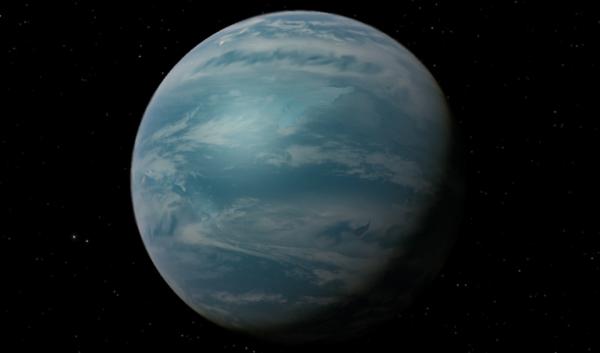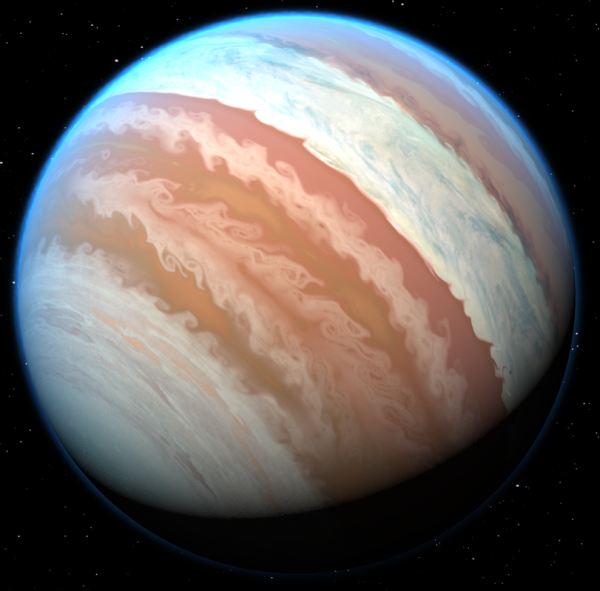BY LETTER
Huycau - Sitr'achra
Galactography > Regions of Space > Middle Regions/Hinter-regions
Sophonts > Xenosophonts > Samaelians
Galactography > Systems and Worlds > Systems & Worlds G - H
Sophonts > Xenosophonts > Samaelians
Galactography > Systems and Worlds > Systems & Worlds G - H
Binary System containing Samael, a world with a unique xenocivilisation | |
 Image from Steve Bowers | |
| Donbetyr, an ocean world in this system with single-celled life | |
Home system of the Samaelians.
In the second tenday of 6802 AT the HIGEX-23 (High Inclination Galactic EXplorer) probe was launched from a spacetime catapult located in the outer reaches of the Apogee Maximal system. Its destination, an ancient cluster of stars located near the galactic north pole known as NGC 1502, lay 2319 light years from the launch site. As it journeyed to its target, the HIGEX-21 probe was tasked with making detailed observations of the Galactic disc as it rose above the Milky Way's horizontal plane and with investigating any star systems it might encounter along the way. About a third of the way along its flight path, HIGEX-1 launched a pair of sub-probes to investigate a nearby neutron star and a binary system slightly farther away. Nearly a century and a half later, the sub-probe (HIGEX-23a) that had been assigned to the neutron star deployed its mag-sail array and began several decades of magnetic braking.
Approaching the stellar remnant, the probe found itself without a sufficient source of nearby raw materials with which to build more specialized subprobes or supporting infrastructure. Instead, the probe dove toward the neutron star, entering a long, looping orbit. Transmitting its data back to the main probe, which relayed the signal back to Apogee Maximal, HIGEX-23a reported the neutron star, designated Cameleopardus SNR274, has a radius of 9.673 kilometers, a mass of 2.982 Solar, and rotational period of 34.077 seconds. SNR274, as determined by analysis of its period, formed more than six billion years ago in a Type II supernova event. The nebula created in the explosion has long since been dispersed into the interstellar medium; the only remaining trace is a slightly lower density of dust and gas surrounding the remnant. Now in a state of quiescence and no longer producing a steady stream of radio-frequency pulses, the neutron star still occasionally emits bursts of cosmic and gamma radiation when matter from the surrounding interstellar medium impacts its ancient surface. The Type II (core collapse) supernova that created Camelopardalis SNR274, it was later discovered, played a major role in the formation of the nearby binary star system.
About one hundred minutes before the star that would become Camelopardalis
SNR274 exploded, neutrinos created by its collapsing layers blasted through its outer surface, carrying with them a highly enriched cloud of heavy nucleons synthesized in the dying star's core. These nucleons, driven by a "wind" of neutrinos, crossed the 27 light years separating the supernova from a nearby molecular cloud of dust and gases. Slamming into the cloud, which had already begun to contract under the influence of the light and radiation from the Camelopardalis SNR274 supernova, heavy nuclei were injected into the protostellar medium, significantly enriching the existing fractions of transition metals (especially molybdenum and tungsten). When the shock wave from the supernova arrived later to compress and heat the cloud still further, the chain of events that would eventually result in the birth and development of the binary system was set into motion.
A second subprobe (HIGEX-23b), launched a decade after the neutron star probe, was dispatched to survey a binary system located only a few light years distant from the main probe's flight path. Although it was not known at the time of the second subprobe's launch, the birth and development of the binary system is inextricably linked to that of the neutron star.
Stellar Data
System ACAF 7319-19063879 A/BRight Ascension 09h53m02.701s
Declination +56°46'54.354
Distance from Sol 2611.138 Light Years (epoch 6000AT)
| Star | A | B |
| Name | Huycau | Sitr'achra |
| Spectral Type | G7V | M0V |
| Mass | 0.906 Solar | 0.508 Solar |
| Radius | 0.945 Solar | 0.523 Solar |
| Luminosity | 0.675 Solar | 0.047 Solar |
| Temperature | 5,630 K | 3,570 K |
| Absolute Magnitude | 5.251 | 8.147 |
| Rotation period | 22.703 days | 16.389 days |
| Barycenter distance | 73.034 A.U. | 130.253 A.U |
| Orbital period | 2437.614 years | 2437.614 years |
| Number of planets | 9 | 11 |
ACAF 7319-19063879 A (Huycau)
The larger star of the binary pair, named Huycau after the Ossetian god of the Sun, is a G7 dwarf that, while nearly as massive as Sol, is only about two-thirds as bright.Planets
| Distance (A.U.) | Name | Type | Radius (km) | Mass (kg) |
| 0.187 | Kurdalaegon | EpistellarSubJovian | 62,821.096 | 3.999e+26 |
| 0.316 | Safa | AzuriMicroJovian | 31,880.295 | 9.965e+25 |
| 0.533 | Donbetyr | Panthalassic | 14,703.434 | 4.857e+25 |
| 1.050 | Tutyr | Europan | 2,646.465 | 3.924e+23 |
| 1.745 | Barastyr | MesoJovian | 69,974.135 | 1.299e+27 |
| 3.833 | Alardy | MicroJovian | 33,506.073 | 1.235e+26 |
| 7.427 | Uacilla | Titanian | 5,582.241 | 2.779e+24 |
| 16.162 | Aminon | Ymirian | 1,179.885 | 1.747e+22 |
| 29.539 | Saubarag | CryoSubJovian | 39,606.725 | 3.892e+26 |
ACAF 7319-19063879 B (Sitr'achra)
The smaller star, named Sitr'achra (the "other side" in Kabbalist mythology) was encountered after its larger sibling. This M-dwarf star has a mass that straddles the divide between the late K-type stars and their M-type brethren, and is nearly twenty-five times dimmer than Sol.Planets
| Distance (A.U.) | Name | Type | Radius (km) | Mass (kg) |
| 0.046 | Usiel | Vesperian | 11,062.246 | 2.483e+24 |
| 0.081 | Azariel | Selenian | 2,126.791 | 1.339e+23 |
| 0.147 | Zomiel | Cytherean | 5,531.633 | 4.118e+24 |
| 0.320 | Sheiriel | MicroJovian | 30,281.495 | 8.042e+25 |
| 0.585 | Ghogiel | SubJovian | 40,671.485 | 2.179e+26 |
| 0.889 | Samael | AreanLacustric | 5,239.116 | 2.963e+24 |
| 1.447 | Theumiel | SuperAreanTundral | 12,802.840 | 9.813e+24 |
| 2.655 | Cathariel | LithicGelidian | 2,749.807 | 2.316e+23 |
| 4.676 | Nehema | CryoSubJovian | 31,868.379 | 1.990e+26 |
| 9.279 | Ogiel | LithicGelidian | 4,769.882 | 1.673e+24 |
| 19.270 | Da'ath | CryoSubJovian | 27,558.354 | 1.524e+26 |
The Huycau-Sitr'achra binary system hosts a total of twenty planets, nine around Huycau and the other eleven orbiting Sitr'achra. Representing a wide diversity of planet types and classifications, the arrangements of these worlds in their respective planetary systems indicate a chaotic and unsettled formative period. This is especially true of the Huycau system, where planetary migrations and planet- planet scattering have resulted in a system architecture featuring two close-in gas giants coexisting with a super-terrestrial and several terrestrial-sized planets interspersed among the other four gas giants in the system. The Sitr'achra system, while perhaps a bit more orderly in its architecture, is nonetheless tightly grouped around its parent star. Despite having a smaller population of worlds, the Huycau planetary system extends more than ten Astronomical Units farther from its central star than does its neighboring system.
 Image from LordOther | |
| Barastyr, a gas giant in this system | |
Notable Worlds
Although the worlds in this system, like those in every planetary system, are individually unique and interesting in its own right, most do not deviate significantly enough from the archetypes established for their planetary classifications to merit further discussion here. Four worlds (one of which is discussed in greater here), however, are sufficiently different and interesting as to indicate a need for further description. These are:Donbetyr (Huycau III), a superterrestrial world almost entirely covered by warm oceans of liquid water. Its surface is dotted with numerous groupings and elongated chains of small islands. The oxygen-rich atmosphere, a product of stellar photolysis of atmospheric water vapor, is nearly Earth-like with a mean surface pressure of 1.2 bars. Weather patterns follow a geostrophic pattern much like that of Earth, with extensive bands of white water vapor clouds swirling in delicate whorls and ill-defined bands across the face of this watery world. This warm world without polar ice-caps appears at first glance to be a tropical paradise. The islands, being both the tops of high mountains and the product of the planet's volcanism, are, however, almost completely barren. Indigenous life has emerged here, though it has apparently not yet reached a true multi-cellular stage of development. Extensive surveys, both above and below the water's surface, have discovered only a few species of algae-like organisms floating just beneath the ocean's surface and a sort of greenish-brown mold growing on some of the islands. The most complex form of animal life found thus far is a type of colonial amoeboid that bands together to form a viscous amphibious slime, living on and near the beaches of the temperate-zone islands.
Usiel (Sitr'achra I) is a tidally-locked planet, closest in its system to Sitr'achra, whose orbit lies within the star's liquid water zone. Oceans cover roughly half of the world's surface, separating large continental landmasses and a few isolated island chains. Mid-ocean waves are raised to a height of 153.716 meters by the upward pull of gravity from Sitr'achra, while land near the sub-stellar point is uplifted by 28.466 meters; these tidal bulges move slowly around the planet as Usiel rotates once per orbit. There are a number of different surface environments, ranging from the very warm regions surrounding the sub-stellar point to the dimly lit frigid regions encircling the poles on the night side. The continents, which are generally ice-free on both hemispheres, are home to vast interior deserts in the mid-latitudes, surrounded by coastal plains drained by extensive river systems. The dense atmosphere is composed mostly of nitrogen with smaller but still significant fractions of carbon dioxide and water vapor, and supports several bands of discontinuous clouds.
The atmosphere rotates rapidly between the warmer day side and the cooler night side, with an average velocity of about 425.638 meters per second in the upper layers.. This rotation is in part driven by the slow rotation of Usiel. Because Usiel is very close to Sitr'achra, heat from its day side is carried by the carbon dioxide in the atmosphere to the night side, keeping surface temperatures at an average of about fifty-five degrees Celsius on both sides of the planet. Detailed examinations of this potentially habitable world, both on land and in its oceans, have failed to detect even the most primitive signs of indigenous life.
Cathariel (Sitr'achra VIII) is a metal-poor, silicate-rich world which possesses a large system of interconnecting caverns beneath its ice-covered surface. These caverns, which may once have been filled with liquid early in the planet's history, are now empty, their previous contents frozen into ices or boiled away through the numerous crevasses and sinkholes peppering the surface. This world represents a hybrid of the better-known icy moons of many outer systems and the Selenian type of planet.
Samael The most notable of the worlds in this binary system is Samael, a cold, ammonia-rich areanlacustric world with a rare metallo-organic biota and an intelligent species known as the Samaelians.
Related Articles
Appears in Topics
Development Notes
Text by Radtech497
Initially published on 30 January 2013.
Initially published on 30 January 2013.






